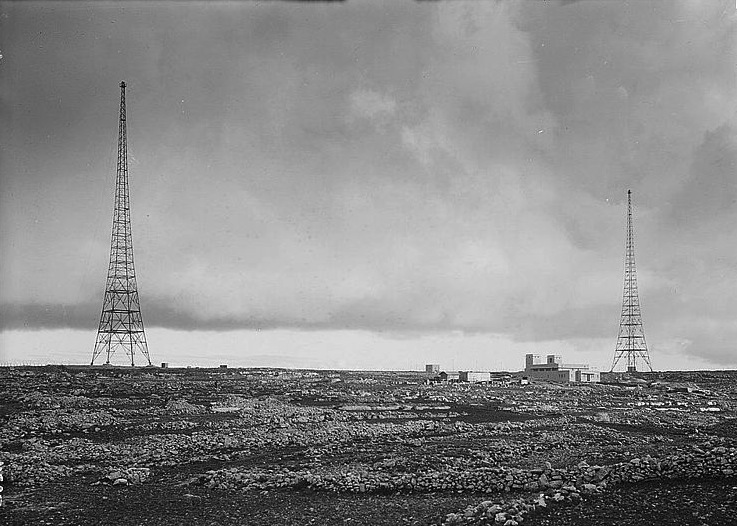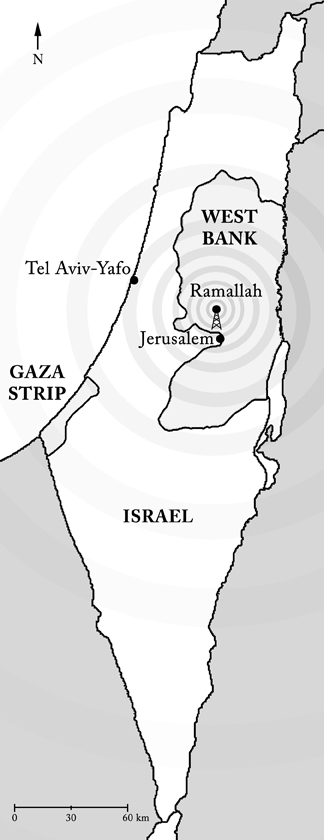מואזין בוכה בראש מסגד גבוה
לילה לבדה מאחורי זכוכית כבדה
משוטט אבל אי אפשר לשמוע
לילה ברדיו ! אולי היא קוראת לי
אני רק זוכר שדה בוער ותופת מלמעלה
חום בעיניים, פתאום אני כאן בלי אף חבר
חדר לבן עלי סוגר, חושך הלילה
לילה, לילה, לילה, לילה, לילה, לילה
רדיו רמאללה לילה ולילה
זה קולה המלחשש מקשקש וכובש 1965
מטשטש אותי
רדיו רמאללה לילה ולילה
יום יבוא נפגש, ניזכר נתרגש
איך היה ב65, לילה, לילה
וככה אני מבזבז אפשרויות
מדמיין את מה שהיה ואת מה שהיה יכול להיות.
זיכרונות מתערבבים בגעגועים
ושורפים, כמו מלח על הפצעים
רעש מכונה בין שדה מוקשים לשדה כותנה
מפלח את הקשר שביננו
לילה לא עונה, אבל עוד יש בי אמונה
אלוהים גדול הוא בטח לצידנו
לילה ברדיו, אולי רק נדמה לי
אני מחפש אותה ואין כלום על הסקאלה
לילה שותקת, רדיו טרנזיסטור מנגן
לו רק יכולתי לטלפן אל לילה הלילה
לילה, לילה, לילה, לילה, לילה, לילה
A muezzin cries atop a tall mosque
Layla is alone, behind heavy glass
Wandering around but it’s impossible to hear
Layla’s on the radio! Maybe she’s calling me
I only remember a burning field and bombs overhead
Heat in my eyes, suddenly I’m friendless here
A white room closes on me. I am alone tonight.
Layla, Layla . . .
[Refrain:]
Radio Ramallah, Layla and night
It’s her whispering voice chattering and conquering 1965
Confounding me
Radio Ramallah, Layla and night
One day we’ll meet, reminisce, and be excited
About how it was in ’65, Layla, Layla
And this is how I waste opportunities
Imagining what was and what could’ve been
Memories mixed with nostalgia
And burning like salt in wounds
Machine noise between cotton and mine fields
Severing the connection between us
Layla doesn’t answer, but I still have faith
G-d is great and is probably on our side
Layla’s on the radio, or maybe it’s just my imagination
I search for her but there’s nothing on the dial
Layla’s silent, a transistor radio plays
If only I could call her on the phone tonight
Layla, Layla . . .
[Refrain]

From a twenty-first-century perspective, it can be difficult to imagine the altogether foreign media paradigm of pretelevision Israel. Radio broadcasting in Mandatory Palestine began under the auspices of the British, who established the Palestine Broadcasting Agency (PBA) in 1936. In 1948, the newly established State of Israel inherited the PBA and rebranded it as Kol Yisra’el, the “Voice of Israel.” Radio was unquestionably the hegemonic media form of the early state, even after the introduction of television to the country in 1968. As in other emergent socialist democracies in the Middle East and Europe, the state broadcasting agency maintained absolute control of radio programming and content, and Kol Yisra’el was the exclusive Israeli station until the establishment of Reshet Bet in 1960, Galei Ẓahal in 1973, and Reshet Gimmel in 1976. Each of these stations remained under the Israel Broadcasting Authority except Galei Ẓahal, which was run by the army. Together, these stations dominated the sonic sphere of Israeli cultural life until the 1990s, when the entrance of satellite television and private media conglomerates brought globalized media to the country at an unprecedented pace.

As the station’s name indicates, Radio Ramallah was based in the Palestinian city of Ramallah, located 20 km north of Jerusalem, and this is where the British Mandate’s Palestine Broadcasting Agency was headquartered before its 1948 relocation to Jerusalem and renaming as Kol Yisra’el. Out of the ashes of the PBA in Ramallah rose Radio Ramallah, a Jordanian-run station that broadcasted through the PBA’s old transmitter at 667 kHz. In contrast to Kol Yisra’el, whose explicit agenda was to facilitate the assimilation of immigrants and pedagogical practices that would serve the Israeli nation-building project, Radio Ramallah’s programming eschewed nationalist politics and was centered on musical cosmopolitanism.
Thus, while Kol Yisra’el transmitted material such as European classical music, with its pretensions to civilization, and Hebrew national song (in addition to news programs and radio dramas), Radio Ramallah specialized in Western and Arab popular music.
For many Israelis, Radio Ramallah was the primary portal through which to experience the outside world sonically from the comfort of home. It is difficult to imagine, furthermore, the emergence of Israeli rock, which since the mid-1960s has been a powerful force in the cultural sphere, without Israeli musicians having had access to the American, British, and continental European records transmitted over Radio Ramallah’s airwaves. The sounds they heard informed the small, bourgeoning rock scene in mid-1960s Ramla, a mixed Jewish-Arab city that sits in central Israel due south of Ben-Gurion Airport. Early rock bands collectively called lehakot ha-keẓev (lit., rhythm bands) performed a repertory that consisted mainly of covers of English-language rock songs they heard on Radio Ramallah, along with some original Hebrew-language compositions that would form the backbone of Israeli rock over the next decade.
This early rock movement, in fact, provided the foundations for Yehuda Poliker to develop his own rock and muzikah yam tikhonit (Mediterranean) style that we hear in “Radio Ramallah,” with its distorted guitar, backbeat drum, Greek bouzouki, synthesizers, and reverb-drenched, melismatic voice, which together evince clear stylistic connections to both Mediterranean Arab and Anglo-American popular music, as noted by Amy Horowitz in Mediterranean Israeli Music. The lyrics, as we have seen, insist on a “memory mixed with nostalgia” for a time during which hearing the Other was an affordance made possible by the nature, and exclusive dominion, of radio technology, before the political and technological developments that would shape post-1967 Israel. In the history signified by this song, we might observe how listening to Others has helped to breed connections, even if only in the imagination. Without such connections, the singer feels “friendless” and “alone.”

